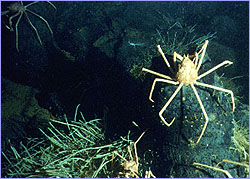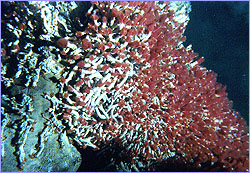
|
 |
 |
Part 2 (back to Part 1) Pressure's on Another factor these creatures have evolved to live with is the pressure. With every 32.8 feet of descent, the weight of the water above increases by 14.7 pounds per square inch. At 7,500 feet, which is about the depth of the black smokers this expedition will attempt to retrieve, the pressure animals feel over every square inch of their bodies is over 3,350 pounds. At such pressures, any air pockets, such as lungs, would be crushed flat as a deflated balloon. Vent animals have evolved bodies with no such air spaces.
Perhaps the most startling condition these animals cope with is unusual temperatures. For they must deal with both extremes—icy and scalding, often simultaneously. Water at the bottom of the ocean is about 35°F, while vent fluids released from chimneys can reach 750°F. Tubeworms and other vent creatures often live right on the flanks of black smokers, within mere inches of the scorching brew, which only the pressure keeps from boiling. Currents constantly stir up the hot and cold, meaning tubeworms and the like have to deal with ever changing temperatures. Even without currents, the extremes are sobering. Biologists have determined that the difference in temperature between a tubeworm's plumed tip and its base anchored in the side of a vent can be more than 50°F. Vent microbes themselves can take temperatures up to 230°F.
To compound problems, the physical environment of the vent itself has limitations. Surprisingly enough considering the vastness of the ocean floor, space is extremely limited. Talk about location, location, location: a tubeworm, for one, must live close enough to a vent to get hydrogen sulfide but not close enough to get burned. To make matters worse, due to geophysical changes taking place beneath them, hydrothermal vents and black smokers can turn off suddenly, choking off the life that depended on them. Even healthy black smokers, though they're made of stone, are fragile structures that eventually crumble beneath their own weight. So vent creatures have to have a means for detecting, traveling to, and colonizing new habitat. Yet vents are spread far and wide throughout the world's seas. How newborn vents acquire new residents is a mystery that continues to keep scientists up at night.
First life? The irony of vent communities is that, despite the harshness of their home, they appear to have survived for many millions of years, having apparently changed little in that time. Vent life, for one thing, appears to be more closely related to ancient animals than anything alive today. What's more, even during times when all hell was breaking loose on the surface, such as during
Some biologists have gone so far as to suggest that a vent-like environment was the place where life on Earth likely got its start. And if such a miracle could have occurred here on Earth, why not on other planets that have the necessary ingredients, including heat, water, and the right mix of chemicals? In the end, there may indeed be a harsher place to live than hydrothermal vents. But again, it hasn't been found ... yet. Peter Tyson is Online Producer of NOVA. Living at Extremes | Inside a Tubeworm | Deep-Sea Bestiary Photos: (1) Visuals Unlimited/©WHOI/D. Foster; (2)IFREMER/Violaine Martin; (3) ©1993 Norbert Wu; (4) NOAA/Pacific Marine Environmental Laboratory ; (5) ROPOS/Urcuyo; (6) ROPOS/Tunnicliffe; (7) V. Tunnicliffe; (8) ©1998 Ken Smith/Mo Yung Productions; (9) ROPOS/Tunnicliffe; (10) IFREMER/Violaine Martin. The Mission | Life in the Abyss | The Last Frontier | Dispatches E-mail | Resources | Table of Contents | Abyss Home Editor's Picks | Previous Sites | Join Us/E-mail | TV/Web Schedule About NOVA | Teachers | Site Map | Shop | Jobs | Search | To print PBS Online | NOVA Online | WGBH © | Updated October 2000 |
||||||||||||
 Spider crabs trundle over a lava mound.
Spider crabs trundle over a lava mound.
 Chimney smoke can be hot enough to melt lead.
Chimney smoke can be hot enough to melt lead.
 Tubeworms live dangerously close to chimney plumes.
Tubeworms live dangerously close to chimney plumes.
 A cascade of tubeworms.
A cascade of tubeworms.
 Did life begin at hydrothermal vents?
Did life begin at hydrothermal vents?